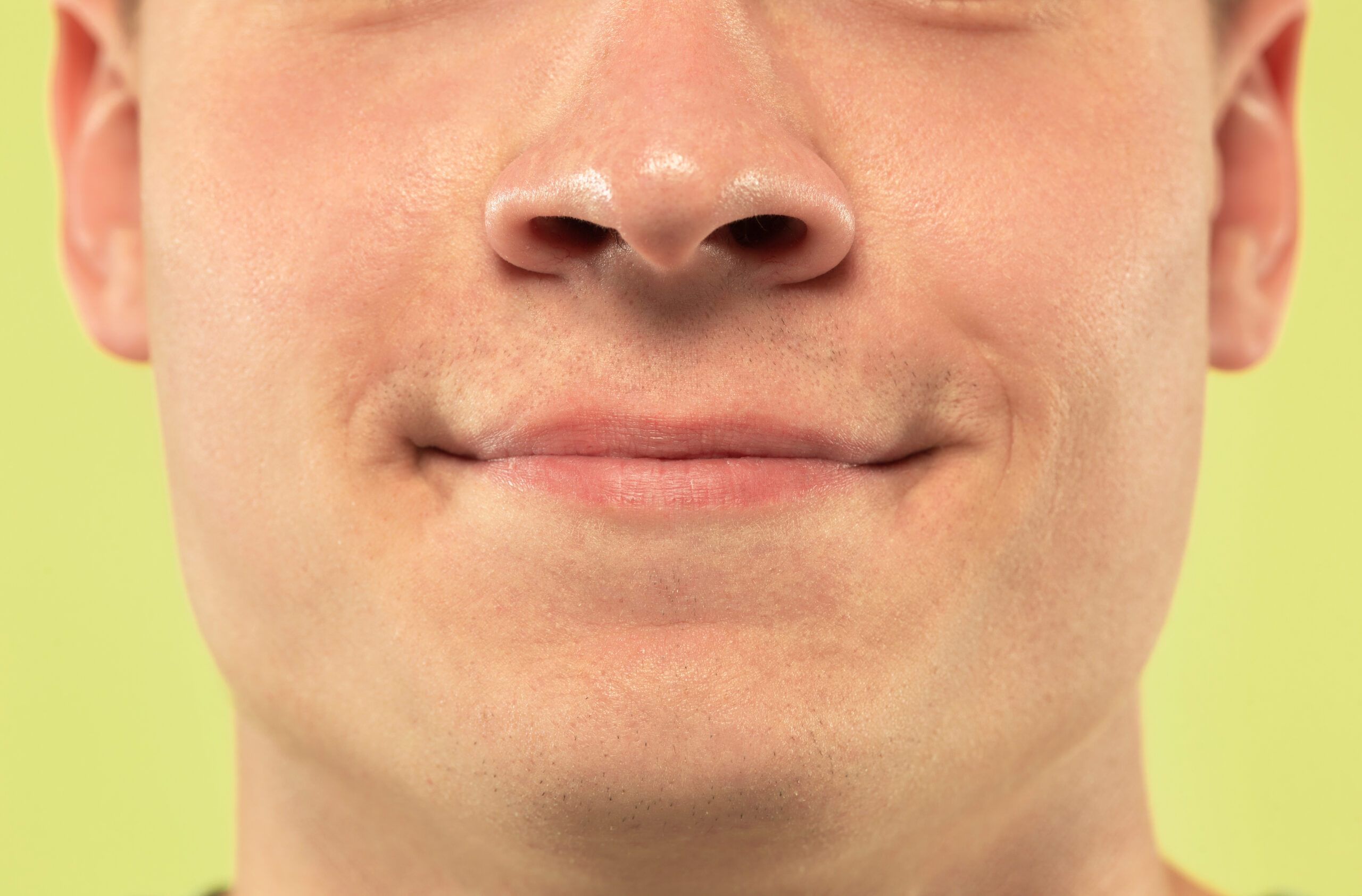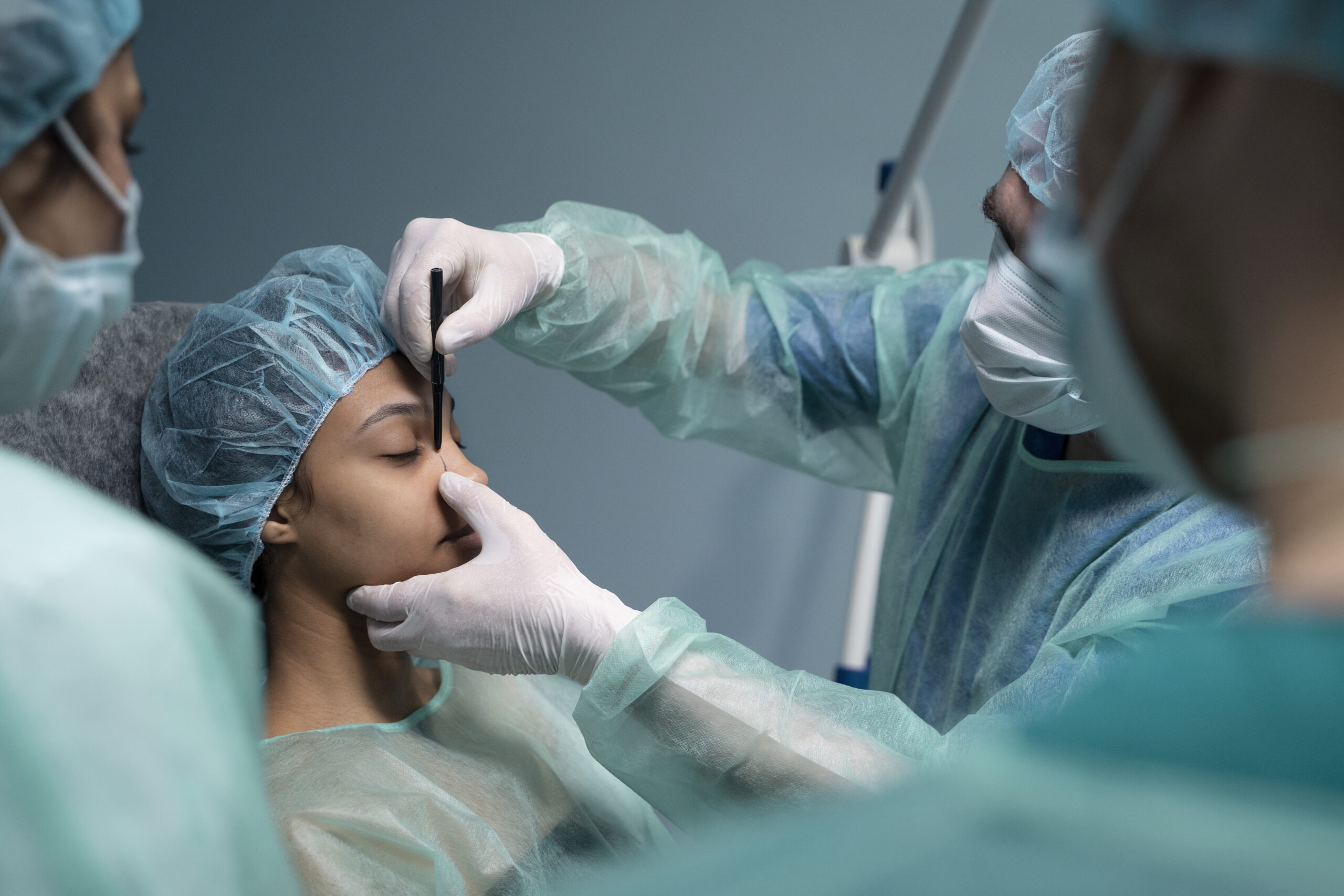A deviated nasal septum is one of the most common ENT diseases. Various injuries cause this condition. A deviated nasal septum may be congenital or acquired. Its correction is one of the most frequently performed nose interventions.
A normal nasal septum consists of cartilage, two bony parts, and a movable piece. It is a simple plate that divides the openings in the nose into two equal or almost equal parts. In people with a deviated septum, it is at an angle or has an unusual shape.
Sometimes, you can also notice other changes that may make breathing difficult and limit airflow through the nose, which is particularly troublesome for patients who complain about this problem.
A deviated septum may take the form of:

A deviated nasal septum![]() has many causes
has many causes![]() . It may be a congenital condition when it does not develop properly, or genetic factors influence its appearance. It also happens that a deviated septum can be acquired as a result of various damages, injuries, or perinatal complications. It is often the result of incorrectly performed previous nasal procedures and subsequent complications. It may also be associated with the occurrence of various diseases.
. It may be a congenital condition when it does not develop properly, or genetic factors influence its appearance. It also happens that a deviated septum can be acquired as a result of various damages, injuries, or perinatal complications. It is often the result of incorrectly performed previous nasal procedures and subsequent complications. It may also be associated with the occurrence of various diseases.
A slightly deviated septum can be observed in most of the population. However, only the occurrence of any symptoms that negatively affect the quality of life qualifies it for treatment.
A deviated nasal septum may not cause any symptoms![]() and may only be associated with a slight aesthetic defect – then, the abnormality is often detected accidentally during a psychical examination. In other cases, it may limit the flow of air through the nasal cavities (unilaterally or bilaterally), i.e., disturb the function of the nose. Cartilaginous and bony septum deviations may be responsible for impaired nasal patency.
and may only be associated with a slight aesthetic defect – then, the abnormality is often detected accidentally during a psychical examination. In other cases, it may limit the flow of air through the nasal cavities (unilaterally or bilaterally), i.e., disturb the function of the nose. Cartilaginous and bony septum deviations may be responsible for impaired nasal patency.
Considering the flow through the nose, the narrowest section is around the valves (internal valves) at the junction of the vestibule with the nasal cavity. This area includes the nasal valve proper and the nasal septum. The head of the turbinate is also located at the level of the nasal valve and influences the regulation of its width. Due to the narrow cross-sectional dimension, even slight irregularities of the nasal septum may cause airflow disturbances through the nose.
Nasal obstruction![]() may be associated with many ailments and symptoms of secondary diseases, including:
may be associated with many ailments and symptoms of secondary diseases, including:

To diagnose![]() a deviated septum, you should visit an otolaryngologist who will conduct a thorough interview with the patient and most likely perform an examination using a rhinoscope. In addition, they may also order a computed tomography scan, which sometimes proves helpful in making a diagnosis. Whether a patient qualifies for a septum straightening procedure is decided not only based on tests but primarily on the symptoms they report. A slight deviation of the septum often causes troublesome symptoms, while a significant deviation does not significantly impede everyday functioning.
a deviated septum, you should visit an otolaryngologist who will conduct a thorough interview with the patient and most likely perform an examination using a rhinoscope. In addition, they may also order a computed tomography scan, which sometimes proves helpful in making a diagnosis. Whether a patient qualifies for a septum straightening procedure is decided not only based on tests but primarily on the symptoms they report. A slight deviation of the septum often causes troublesome symptoms, while a significant deviation does not significantly impede everyday functioning.
There are no perfectly straight nasal septums “in nature.” As long as the deviation of the nasal septum does not lead to ventilation and breathing disorders, it is treated as usual. The problem begins when a deviated septum disrupts the airflow through the respiratory tract. The most common effect of this state of affairs is unilateral or bilateral nasal obstruction or blockage. The symptoms worsen significantly during sleep and lead to sleep disorders, including dangerous sleep apnea. Another common symptom is recurrent infections of the nasal sinuses.
The consequence of a deviated nasal septum is also:
Significant and untreated deviation of the nasal septum may lead to severe complications. While in young people, impaired airflow through the nose can be compensated for by breathing through the mouth without significant consequences, in the case of older people, it becomes a problem. Due to numerous comorbidities (e.g., respiratory or circulatory system diseases), their oxygen demand is relatively high. Breathing problems may worsen the blood supply to organs, which, in extreme cases, results in episodes of heart ischemia or exacerbation of the symptoms of heart failure.
Breathing difficulties may increase with age. It is not related to the increasing deviation of the septum but to the appearance of additional factors affecting the patency of the nose, i.e., allergic swelling and hypertrophy of the nasal turbinates. There is also an increased demand for oxygen, poorer adaptation capabilities, and increasing symptoms of chronic hypoxia.
Indications for septum surgery include difficulty breathing, discomfort during everyday functioning, as well as:
It also happens that nasal septum surgery is treated as preparation for other procedures performed in this area. The doctor always qualifies you for surgery, and during it, the external appearance of the nose can also be improved. Before correcting the septum deviation, a complete set of tests must be performed.
Currently, the procedure can be performed on people of virtually any age without contraindications. Examples of limitations include blood clotting disorders, acute sinusitis, infections, and problems with the nasal mucosa. Most of them, however, are only temporary, so after the symptoms disqualifying the procedure have subsided or been cured, it can be performed.
A deviated septum is a disorder of the anatomical structure of the nose that occurs in most adults. The presence of troublesome symptoms that make everyday functioning difficult determines whether there are indications for surgery. When the nasal septum surgery is performed, and the affected tissues heal, the patient begins to feel the positive effects of the procedure. These include, for example, easier breathing, reducing the risk of inflammation in the respiratory tract, and solving the problem of snoring. It significantly improves the quality of life for most people.
A deviated septum is such a troublesome condition that perioperative issues are not that bothersome for patients. On the day of the procedure, you should come to the surgery on an empty stomach, without applying cosmetics to your skin beforehand. It is a good idea to take any medications you take with you. After the procedure, the specialists usually recommend performing seawater irrigation and limiting physical activity to create comfortable conditions for healing. In addition, it is necessary to use special ointments prescribed by a doctor to prevent nasal dryness. Patients also take the proposed antihemorrhagic and analgesic drugs.

Septoplasty![]() is performed on the inner part of the nose. Its purpose is to straighten a deviated septum or remove deformations, growths, and other irregularities. During the procedure, the specialist removes the excess tissue. Then, their placement is rearranged, and the correct partition is formed. The operation is most often performed under general anesthesia. Still, in some cases, it is possible to perform it only under local anesthesia, especially when there are contraindications to anesthesia but not to septoplasty.
is performed on the inner part of the nose. Its purpose is to straighten a deviated septum or remove deformations, growths, and other irregularities. During the procedure, the specialist removes the excess tissue. Then, their placement is rearranged, and the correct partition is formed. The operation is most often performed under general anesthesia. Still, in some cases, it is possible to perform it only under local anesthesia, especially when there are contraindications to anesthesia but not to septoplasty.
The operation begins with the administration of anesthesia. Then, the doctor makes cuts around the nose to separate the cartilage from the mucous membrane. Next, it cuts out the abnormal parts of the septum and applies sutures, which may or may not be dissolvable. If regular stitches are used, they must be removed later during inspection. The patient goes home the same day. Convalescence is not excessively burdensome. The bandages should be removed from the nose 48 hours after the procedure. Stabilizing plates, if used, are removed after 7-10 days.
Rhinoplasty![]() is often performed when the nasal septum needs to be corrected. It involves improving the aesthetic value of the nose, especially the external one. It may involve removing a hump, or potential unevenness, reducing the tip of the nose, improving its symmetry, or turning it slightly upwards. Rhinoplasty is performed using an open or closed method. The first one gives the doctor much greater access to the operated nose but is more invasive. The second one is used when the changes only affect the bridge of the nose.
is often performed when the nasal septum needs to be corrected. It involves improving the aesthetic value of the nose, especially the external one. It may involve removing a hump, or potential unevenness, reducing the tip of the nose, improving its symmetry, or turning it slightly upwards. Rhinoplasty is performed using an open or closed method. The first one gives the doctor much greater access to the operated nose but is more invasive. The second one is used when the changes only affect the bridge of the nose.
Conchoplasty![]() (turbinate surgery) is a procedure that aims to improve the nasal turbinates. Combined with septoplasty, it can give many positive results. It usually enhances nasal obstruction, reduces unpleasant symptoms related to allergies or runny noses, and eliminates snoring and sleep apnea. Conchoplasty is performed under local anesthesia. There is usually no need to use general anesthesia. It can be performed using a laser or radio waves, which help reduce enlarged turbinates. Tamponade is not used after the procedure because the potential bleeding is not severe.
(turbinate surgery) is a procedure that aims to improve the nasal turbinates. Combined with septoplasty, it can give many positive results. It usually enhances nasal obstruction, reduces unpleasant symptoms related to allergies or runny noses, and eliminates snoring and sleep apnea. Conchoplasty is performed under local anesthesia. There is usually no need to use general anesthesia. It can be performed using a laser or radio waves, which help reduce enlarged turbinates. Tamponade is not used after the procedure because the potential bleeding is not severe.